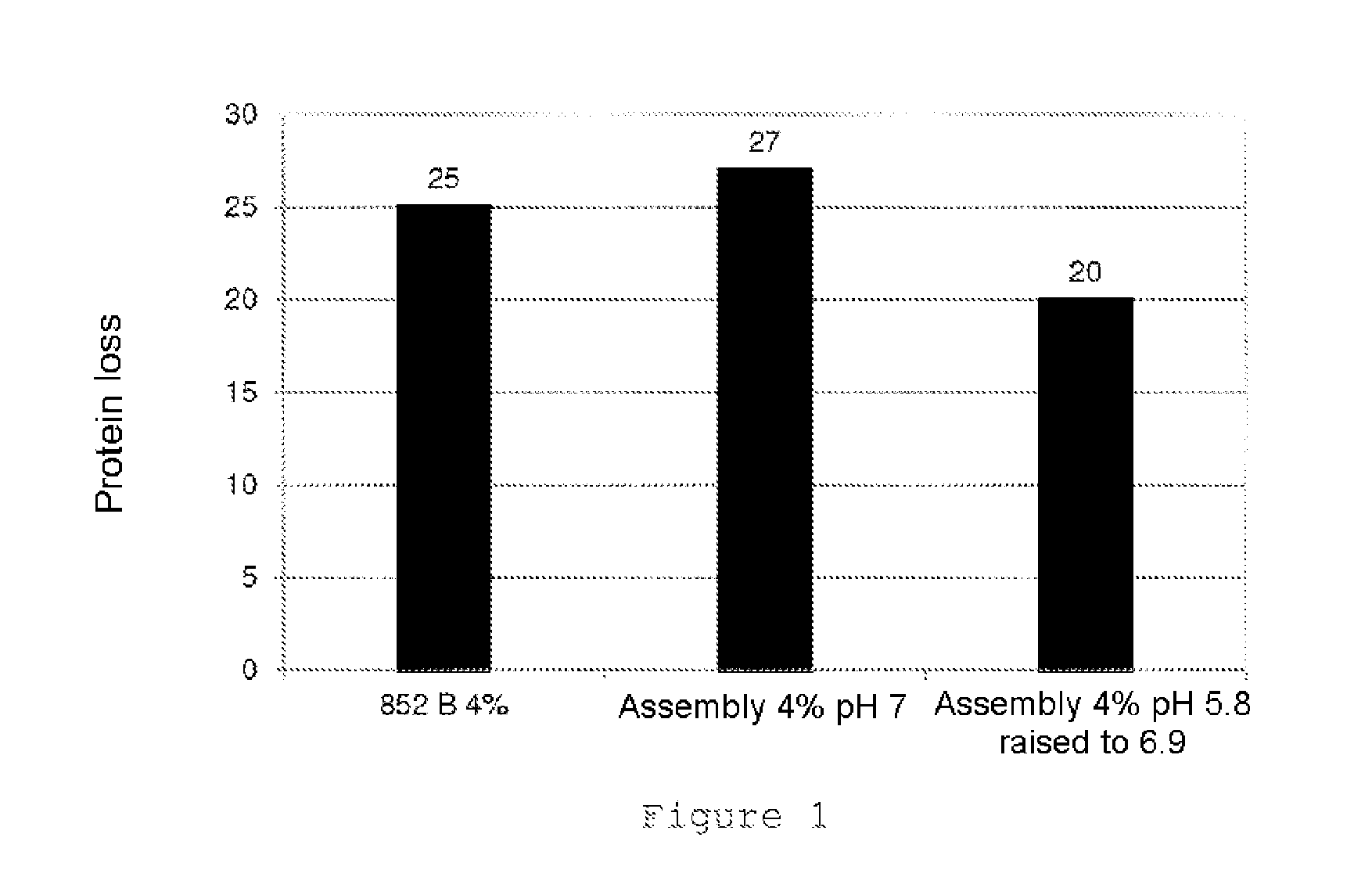Assembly of at least one vegetable protein and at least one dairy protein
a technology of vegetable protein and dairy protein, which is applied in the direction of peptides, plant/algae/fungi/lichens, baking products, etc., can solve the problems of unsatisfactory needs, unsatisfactory, and curbish use of substitute proteins currently available on the market, so as to achieve real synergy and improve functional and/or sensory properties.
- Summary
- Abstract
- Description
- Claims
- Application Information
AI Technical Summary
Benefits of technology
Problems solved by technology
Method used
Image
Examples
example 1
Preparation of the Protein Assemblies
A. Raw Materials
[0282]Dairy Proteins:
[0283]The dairy proteins used are derived from a milk fraction and contain 92% of micellar caseins relative to the total nitrogenous matter. This batch is called micellar casein retentate Promilk 852 B sold by the company Ingredia, and is in liquid form (retentate containing 15% of solids), stabilized by addition of 0.02% of bronopol (preservative), and stored at 4° C.
[0284]Vegetable Proteins:
[0285]The examples were carried out with three different batches of pea proteins.[0286]A batch of pea proteins obtained by ultrafiltration referred to as UF. This batch was obtained by passing a liquid extract of Nutralys® S85 M sold by the company Roquette Fréres over a membrane with a cut-off threshold of 50 KD. The purified proteins obtained were concentrated by diafiltration according to the conventional techniques until a concentrated solution containing 75% proteins was obtained. Finally, the protein concentrate was...
example 2
[0314]In order to determine the protein content in the various samples, the assaying of the soluble nitrogenous fraction contained in the sample can be carried out according to the Kjeldahl method (NF V03-050, 1970). The ammoniacal nitrogen determination is based on the formation of a colored complex between the ammonium ion, sodium salicylate and chlorine, the strength of the coloration of which is measured at 660 nm. This method is carried out with a Technicon automatic continuous liquid flow apparatus.
[0315]The protein content of the samples is estimated by multiplying their nitrogen content by the conversion factor 6.25.
[0316]This method is well known to those skilled in the art.
[0317]In order to determine the soluble protein content, the content of soluble proteins in water of which the pH is adjusted to 7.5+ / −0.1 using an HCl or NaOH solution is measured by means of a method of dispersion of a test specimen of the sample in distilled water, centrif...
example 3
Results of the pH-Lowering Strategy
[0318]The objective of the lowering of the pH (2.5) as described in example 1 above is to solubilize the pea proteins in order to change their conformation and to bring about their folding in such a way that their hydrophobic sites are exposed to the solvent and can interact with the dairy proteins.
[0319]Table 1 below shows the soluble and insoluble fractions of the pea proteins as a function of the pH.
TABLE 1pH 2.5 raised Pea proteinspH 7to 7Total concentration1616(mg / ml)Soluble fraction (mg / ml)7.510.7Insoluble fraction8.55.3(mg / ml)
[0320]The assaying of the soluble proteins in the pea protein solutions shows an improvement in the solubility with the lowering of the pH. Indeed, the solution of 16 mg / ml has a soluble fraction of 7.5 mg / ml, at pH 7, whereas up to 10.7 mg / ml are solubilized by lowering the pH to 2.5 and raising it back up to 7.
PUM
| Property | Measurement | Unit |
|---|---|---|
| Conformation | aaaaa | aaaaa |
Abstract
Description
Claims
Application Information
 Login to View More
Login to View More - R&D
- Intellectual Property
- Life Sciences
- Materials
- Tech Scout
- Unparalleled Data Quality
- Higher Quality Content
- 60% Fewer Hallucinations
Browse by: Latest US Patents, China's latest patents, Technical Efficacy Thesaurus, Application Domain, Technology Topic, Popular Technical Reports.
© 2025 PatSnap. All rights reserved.Legal|Privacy policy|Modern Slavery Act Transparency Statement|Sitemap|About US| Contact US: help@patsnap.com

